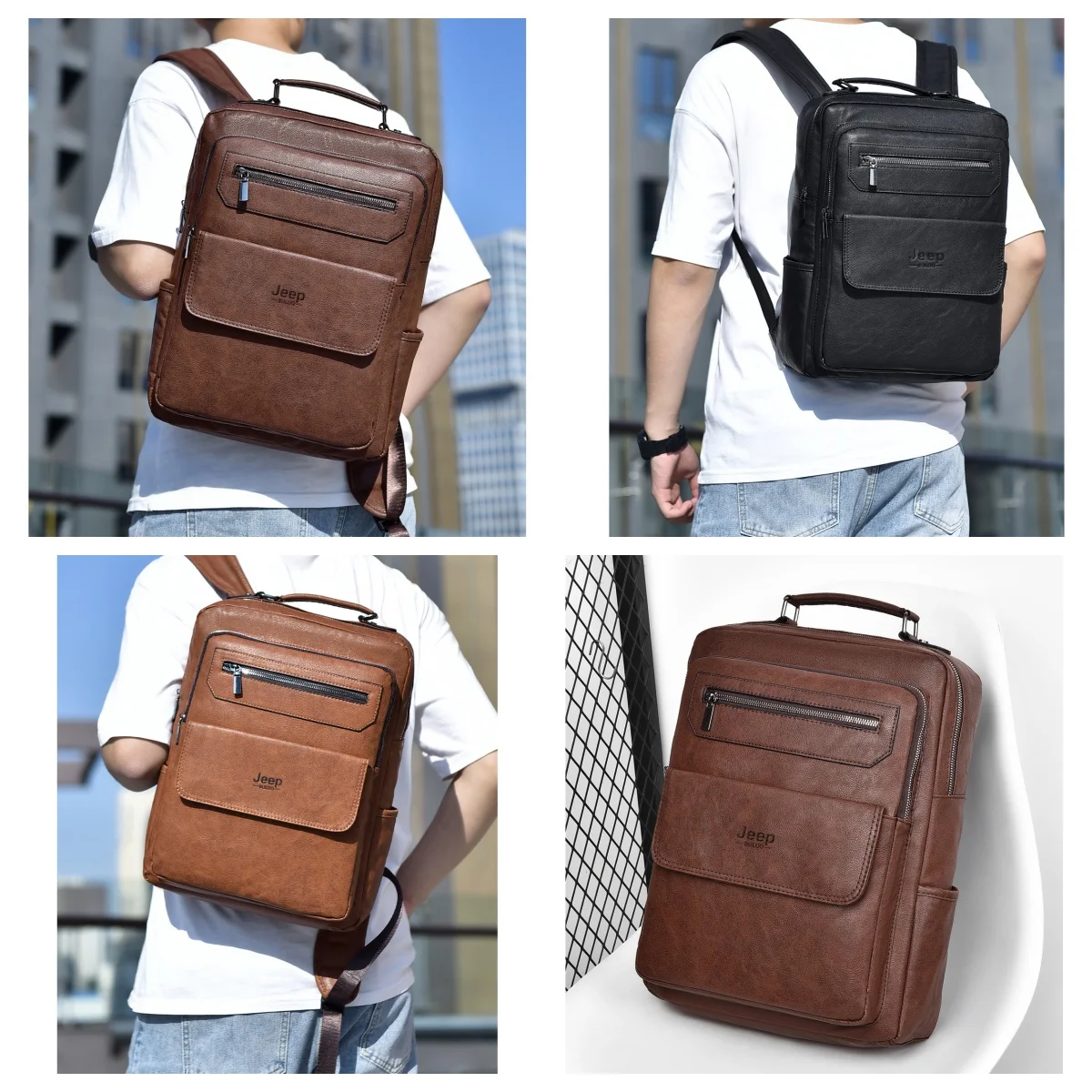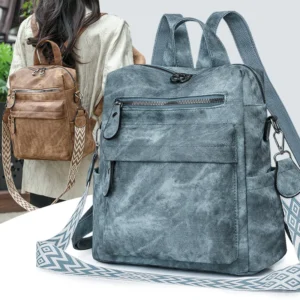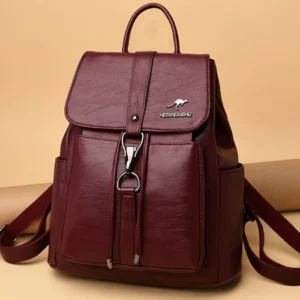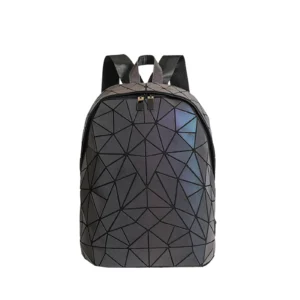Introduction: Why Proper Leather Backpack Storage Matters
A quality leather backpack isn’t just an accessory—it’s an investment that deserves proper care, especially during periods of disuse. Proper storage techniques can dramatically extend the lifespan of your leather backpack, maintain its appearance, and prevent structural damage that occurs when left unattended.
Many leather backpack owners unknowingly damage their prized possessions through common storage mistakes: stuffing them in crowded closets, leaving them exposed to sunlight, or neglecting conditioning before extended storage. With proper care, a premium leather backpack can last decades rather than years, developing a rich patina that enhances its character over time.
At Summit Carry, we believe that understanding leather conditioning and waterproofing is fundamental to preserving your investment for years to come. That’s why we’ve created this comprehensive guide to leather backpack storage.
Key benefits of proper leather storage:
– Extends useful life by 5-10+ years
– Preserves structural integrity and shape
– Prevents cracking, drying, and color fading
– Maintains supple texture and natural leather oils
– Protects hardware from tarnishing or corrosion
Understanding Leather Properties and Vulnerabilities
To properly store a leather backpack, you must first understand what makes leather unique as a material. As a natural product derived from animal hide, leather “breathes” and responds dynamically to environmental conditions. This natural quality makes leather both remarkably durable and simultaneously vulnerable to specific storage hazards.
Moisture Sensitivity
Leather maintains a delicate moisture balance. Too much humidity and it becomes susceptible to mold and mildew; too little moisture and the fibers become brittle and crack. During storage, leather continues to absorb and release moisture from the surrounding environment.
Temperature Vulnerability
Extreme temperatures damage leather at the molecular level. Heat accelerates drying and can shrink leather fibers, while cold temperatures can make leather stiff and more prone to cracking when handled. The ideal storage temperature falls within a moderate range that mimics room temperature.
UV Light Damage
Prolonged exposure to sunlight causes leather to fade unevenly and become dry and brittle. The UV rays break down the natural oils in the leather, accelerating deterioration. Even artificial light can cause damage over extended periods.
Shape Distortion
Without proper support, leather backpacks can develop permanent creases, folds, and deformations during storage. The weight of the leather itself can cause stretching and sagging, particularly in areas like straps and bottom panels.
Premium full-grain leather backpacks are particularly sensitive to storage conditions due to their minimal processing and natural characteristics. Understanding the ultimate guide to conditioning leather backpacks can help you maintain the optimal moisture balance that prevents storage-related damage.
Essential Pre-Storage Cleaning Protocol
Before storing your leather backpack, thorough cleaning is essential to remove dirt, oils, and residues that could damage the leather over time. Follow this systematic approach:
Complete emptying process
– Empty all main compartments
– Check and clear all hidden pockets and crevices
– Remove any detachable parts and clean separately
– Shake gently to dislodge debris from seamsSurface cleaning techniques
– Use a soft, dry cloth to remove surface dust
– Wipe with a slightly damp cloth (not wet) for general cleaning
– Allow to fully air dry away from direct heat sources
– Never store a damp or wet leather backpackSpot treatment
– Address stains with a leather-specific cleaner
– Test cleaner on an inconspicuous area first
– Use minimal moisture and gentle circular motions
– Allow spots to dry completely before conditioningHardware cleaning
– Clean metal buckles, zippers, and fixtures with a dry cloth
– Remove tarnish with appropriate metal cleaner if needed
– Ensure hardware is completely dry to prevent water spots
– Consider applying a light coating of metal protectant for long-term storage
The complete cleaning process typically takes 30-60 minutes, with an additional 24 hours of drying time before the next steps. Watch for excessive dryness or stiffness after cleaning, which signals the need for conditioning.
For backpacks used during travel that may have picked up additional grime or environmental exposure, specialized DIY leather care techniques for travel backpacks can provide additional cleaning approaches before storage.
Conditioning: The Essential Pre-Storage Treatment
Conditioning your leather backpack before storage is perhaps the most crucial step in preventing deterioration. Think of conditioning not simply as adding oil, but as restoring the leather’s natural moisture balance that will protect it during dormant periods.
Selecting the right conditioner is vital—use only products specifically formulated for the type of leather your backpack is made from. For premium leather backpacks, avoid petroleum-based products which can damage the leather over time.
Apply conditioner properly using these steps:
- Start with a small amount of conditioner on a soft, lint-free cloth
- Work in thin layers using gentle circular motions
- Cover the entire surface, paying special attention to seams and stress points
- Allow the conditioner to penetrate for 10-15 minutes (longer isn’t better)
- Gently buff away any excess with a clean cloth
- Let the backpack rest for 24 hours before storage
For short-term storage (1-2 months), a single conditioning treatment is usually sufficient. For long-term storage (3+ months), a more thorough conditioning may be necessary, potentially with a second light application after the first has fully absorbed.
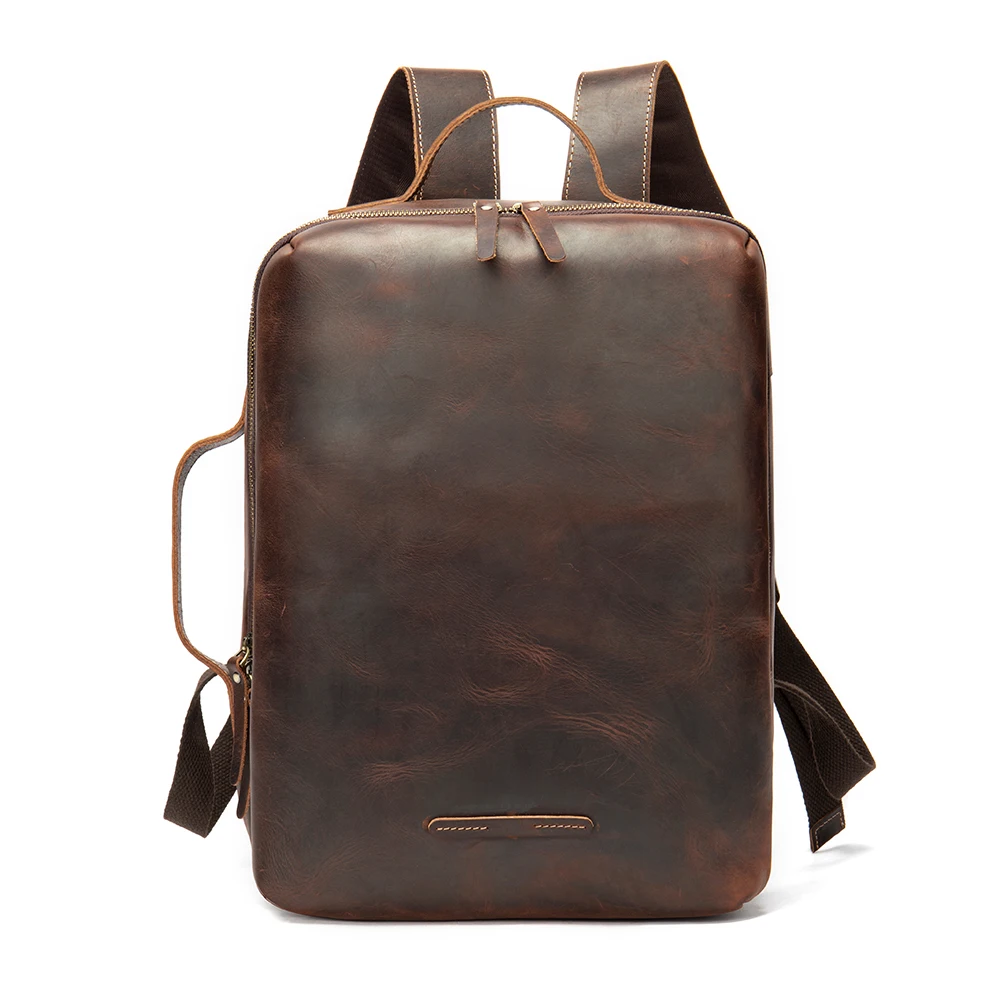
Understanding whether your leather should dry completely before conditioning is critical—applying conditioner to damp leather can trap moisture and cause mildew problems during storage.
Warning signs of improper conditioning include:
– Over-conditioning: sticky residue, darkened appearance
– Under-conditioning: stiff texture, visible dryness, lack of suppleness
Creating Optimal Environmental Conditions
The environment where you store your leather backpack directly impacts its condition over time. Creating optimal storage conditions doesn’t require specialized equipment—just attention to key environmental factors.
| Factor | Ideal Conditions | Danger Zone | Simple Test Method |
|---|---|---|---|
| Temperature | 65-75°F (18-24°C) | Below 40°F or above 85°F | Indoor thermometer |
| Humidity | 45-60% | Below 30% or above 70% | Humidity gauge or monitor |
| Light | Minimal to none | Direct sunlight or bright artificial light | Light meter app on smartphone |
| Air Circulation | Moderate | Stagnant air or direct drafts | Smoke trail test |
Best Home Storage Locations
- Bedroom closet – Usually maintains consistent temperature; add humidity control if needed
- Under the bed – Good if using a breathable storage container
- Hall closet – Check for temperature stability away from exterior walls
- Avoid at all costs – Basements (too humid), attics (temperature extremes), garages (humidity fluctuations)
For environmental control without specialized equipment:
– Use silica gel packets to absorb excess humidity (replace every 3-6 months)
– Position away from heating vents, radiators, and air conditioners
– Keep out of direct sunlight and away from windows
– Avoid exterior walls that may transfer temperature changes
Leather commuter backpack care tips include environmental protection strategies that work equally well for storage situations, particularly for managing humidity exposure that occurs during daily use and then continues during storage.
Leather travel backpacks often require special attention to environmental conditions during storage, as they’re typically used intermittently and may be exposed to diverse climates during their use.
Shape Preservation Techniques
Maintaining your leather backpack’s shape during storage prevents permanent creasing and structural damage. The key is providing internal support that mimics how the backpack looks when in use.
Effective Stuffing Materials:
- Best: Acid-free tissue paper—pH neutral, breathable, conforms easily
- Good: Clean cotton t-shirts or towels—breathable, readily available
- Acceptable: Bubble wrap covered with fabric—provides structure but allows less airflow
- Avoid: Newspaper (ink transfer), colored tissue paper (dye transfer), plastic bags (trap moisture)
Step-by-Step Stuffing Process:
- Begin with the main compartment, filling evenly from bottom to top
- Support corners and edges where creasing might occur
- Fill to approximately 80-90% capacity—enough to maintain shape without stretching
- Stuff small compartments and pockets individually
- Pay special attention to areas that tend to collapse (front pockets, sides)
- For backpacks with flaps, support the flap in its natural closed position
Address Problem Areas:
- Straps: Roll small fabric tubes and place inside or along straps to prevent creasing
- Bottom sagging: Create a firm but cushioned base support with folded acid-free paper
- Collapsing top: Ensure upper sections are adequately filled without overstuffing
The perfect stuffing density feels firm but with slight give when pressed—similar to a medium-soft pillow. This maintains shape without placing stress on seams or zippers.
Protective Covering Strategies
After proper cleaning, conditioning, and stuffing, your leather backpack needs protection from dust and environmental elements while still allowing the leather to breathe.
Covering Options Comparison
| Covering Type | Pros | Cons | Best For |
|---|---|---|---|
| Cotton dust bag | Excellent breathability, prevents scratches, blocks dust | May not block all light, less structure | Ideal for most storage situations |
| Pillowcase | Readily available, good breathability, washable | May not fit perfectly, thinner material | Short-term or emergency storage |
| Breathable fabric cover | Can be custom-sized, durable protection | Requires sewing or purchasing specially | Long-term or valuable backpacks |
Proper Covering Technique:
- Ensure the covering is clean and completely dry
- Gently place the bag over the stuffed backpack, avoiding catching on hardware
- Arrange the covering to fully enclose the backpack without compressing it
- If using drawstrings, close loosely to allow some air circulation
- Position the covered backpack in its storage location without stacking items on top
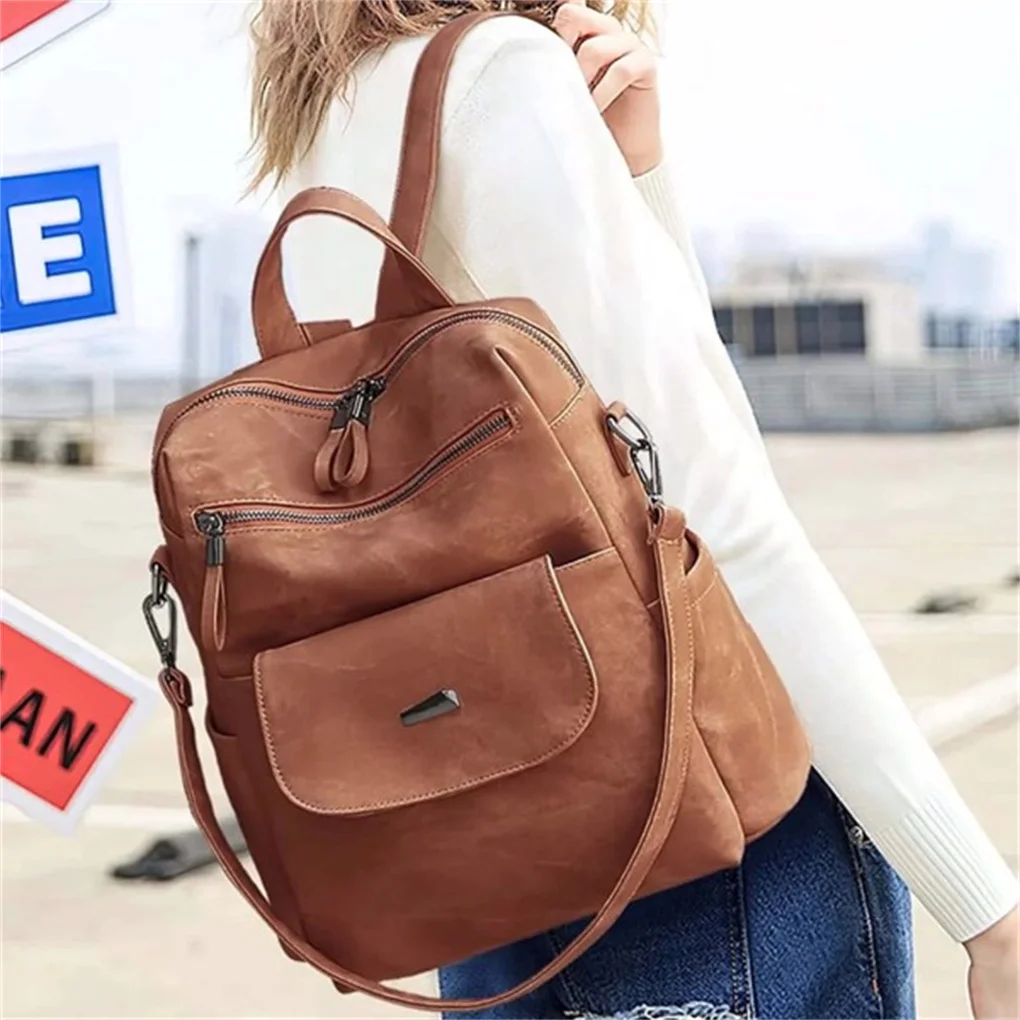
Critical: Never use plastic bags, dry cleaning bags, or airtight containers for leather storage. These trap moisture against the leather and can cause mildew, mold, and leather deterioration.
Vintage leather backpacks particularly benefit from proper protective covering, as their aged leather may be more susceptible to environmental damage during storage periods.
Short-Term vs. Long-Term Storage Protocols
Different storage durations require different approaches to leather backpack care. Adapt your storage protocol based on how long your backpack will remain unused.
| Factor | Short-Term (2-8 weeks) | Long-Term (3+ months) |
|---|---|---|
| Cleaning | Basic surface cleaning | Deep cleaning including seams and hardware |
| Conditioning | Light conditioning | Thorough conditioning, possibly multiple applications |
| Stuffing | Basic shape support | Complete structural support with attention to details |
| Covering | Simple dust cover | Full protective covering with humidity consideration |
| Positioning | Can remain hanging if properly supported | Should lay flat or stand upright with support |
| Maintenance | Not typically needed | Regular checking and repositioning |
Short-Term Storage Quick Protocol
For brief storage periods, focus on keeping your backpack clean and supported. Simply clean the surface, apply a light conditioner, stuff loosely to maintain shape, and cover with a breathable cloth in a cool, dry place.
Long-Term Storage Comprehensive Protocol
For seasonal or extended storage:
1. Complete thorough cleaning inside and out
2. Apply two rounds of conditioning, allowing absorption between applications
3. Stuff carefully to support all structural elements
4. Cover completely with a breathable cotton bag
5. Store in a temperature-controlled, dark location
6. Check monthly for condition changes
7. Recondition lightly every 3-4 months
The principles of leather maintenance for commuters provide excellent baseline knowledge that can be applied to both short and long-term storage situations, as the fundamentals of leather care remain consistent.
Specialized Storage for Different Leather Types
Each type of leather has unique properties that require specific storage considerations. Tailor your approach based on your backpack’s leather type.
Full-Grain and Top-Grain Leather
These premium leathers require regular conditioning before storage to maintain their natural oils. When properly conditioned, they develop a beautiful patina over time, even in storage. Store flat or standing upright with proper internal support, as hanging can stretch full-grain leather over time.
Suede and Nubuck
These delicate leathers require special care:
– Never use liquid leather conditioners
– Brush thoroughly before storage with a suede brush
– Use specialized suede protector spray before long-term storage
– Keep extremely well-protected from dust and light
– Use slightly less stuffing pressure to avoid compressing the nap
Patent Leather
This glossy leather needs particular attention:
– Clean thoroughly with a damp cloth and mild soap
– Avoid all oil-based conditioners
– Place tissue paper between touching patent leather surfaces to prevent sticking
– Store in a slightly cooler environment to prevent the finish from becoming tacky
Vegetable-Tanned Leather
This traditional leather develops unique character:
– Condition thoroughly before storage
– Protect diligently from light exposure which can cause uneven patina
– Check more frequently during storage as it’s more responsive to environmental changes
For compact designs, the storage considerations for compact leather backpacks for travel apply particularly well, as these specialized bags often have unique construction elements that need protection.
Luxury leather backpacks typically use the highest quality leathers that require the most attentive storage protocols to preserve their exceptional characteristics and value.
14 Inch Leather Laptop Backpack, Brown Leather Backpack, Men's Leather Backpack, Vintage Leather Backpack
Price range: $177.28 through $199.12 Select options This product has multiple variants. The options may be chosen on the product pageCarry On Leather Backpack, Roll Top Leather Backpack
Price range: $77.76 through $96.48 Select options This product has multiple variants. The options may be chosen on the product page17 Inch Leather Laptop Backpack, Men's Leather Travel Backpack, Men's Leather Work Backpack
Price range: $106.28 through $143.88 Select options This product has multiple variants. The options may be chosen on the product pageBlack Leather Backpack, Small Leather Backpack, Women's Leather Backpack
Price range: $112.96 through $116.12 Select options This product has multiple variants. The options may be chosen on the product pageLuxury Leather Backpack, Small Leather Backpack, Women's Leather Backpack
Price range: $137.48 through $138.28 Select options This product has multiple variants. The options may be chosen on the product pageDesigner Women's Backpack, Luxury Leather Backpack
Holographic Geometric Laser Diamond PU Leather Women’s Fashion Backpack with Glow-in-the-Dark Design$112.20 Select options This product has multiple variants. The options may be chosen on the product page
Troubleshooting Common Storage Problems
Even with careful preparation, storage issues can arise. Here’s how to address common leather backpack storage problems:
Q: I found mold or mildew on my stored leather backpack. What should I do?
Solution: Move to a dry area immediately. Gently wipe the affected area with a cloth dampened with equal parts water and isopropyl alcohol. Allow to dry completely away from heat, then apply leather conditioner. Improve storage location ventilation and consider using silica gel packets.
Q: My backpack has developed deep creases during storage. Can these be fixed?
Solution: Stuff the backpack thoroughly, focusing on supporting the creased area. Apply leather conditioner to the creased section and gently massage. Allow the backpack to remain stuffed for several days in a warm (not hot) room. For severe creases, steam from a distance may help relax the leather before conditioning.
Q: The leather has become extremely dry and stiff after storage. How can I restore it?
Solution: Apply a quality leather conditioner in multiple light coats, allowing 12-24 hours between applications. Don’t oversaturate. After conditioning, stuff the bag properly and allow it to rest for 48 hours before use. For extremely dried leather, a specialized leather restoration product may be necessary.
Q: There’s an unpleasant musty odor after storage. How do I eliminate it?
Solution: Air out the backpack in a well-ventilated area away from direct sunlight for 48-72 hours. Place odor-absorbing materials like baking soda in a cloth bag inside the backpack for 24 hours, then remove. For persistent odors, consider professional leather cleaning.
Q: The hardware has tarnished during storage. What’s the best way to clean it?
Solution: For brass or copper: make a paste with equal parts salt, flour, and white vinegar. Apply gently, let sit briefly, then rinse and dry thoroughly. For other metals, use appropriate metal cleaners and apply a metal protectant before returning to storage.
Storage Location Comparison Guide
Where you store your leather backpack significantly impacts its condition. Here’s how common home locations compare:
| Location | Temperature | Humidity | Light | Overall Rating |
|---|---|---|---|---|
| Bedroom closet | ★★★★☆ | ★★★★☆ | ★★★★★ | Excellent |
| Under bed | ★★★★☆ | ★★★★☆ | ★★★★★ | Very Good |
| Coat closet | ★★★★☆ | ★★★☆☆ | ★★★★★ | Good |
| Living room cabinet | ★★★☆☆ | ★★★☆☆ | ★★☆☆☆ | Fair |
| Basement | ★★☆☆☆ | ★☆☆☆☆ | ★★★★★ | Poor |
| Attic | ★☆☆☆☆ | ★★☆☆☆ | ★★☆☆☆ | Very Poor |
| Garage | ★☆☆☆☆ | ★☆☆☆☆ | ★★★☆☆ | Very Poor |
Improving Problematic Locations
If you must use a less-than-ideal storage location, consider these improvements:
For Basements:
– Use a dehumidifier to maintain 50% relative humidity
– Place backpack in a sealed plastic container with silica gel packets
– Position container on a shelf off the floor
– Check monthly for humidity issues
For Attics:
– Only use during moderate seasons (spring/fall)
– Add insulation around storage area
– Use a thermometer to monitor temperature extremes
– Consider a climate-controlled storage alternative during summer/winter
Small leather backpacks offer more flexibility in storage locations due to their compact size, making them easier to place in optimal home environments like bedroom closets or dresser drawers.
Professional Storage Options and Services
When storing particularly valuable leather backpacks or for very long periods, professional services may be worth considering:
When to Consider Professional Storage:
- For rare, vintage, or high-value leather goods
- During extended travel or relocation
- In homes with extreme environmental conditions
- For collections that exceed available proper storage space
What to Look for in Professional Leather Storage Services:
- Climate-controlled environment (constant temperature and humidity)
- Security features for valuable items
- Regular inspection and maintenance protocols
- Specialized leather care expertise
- Insurance coverage for stored items
Questions to Ask Potential Storage Services:
- What specific environmental controls are maintained?
- How are items protected from dust, light, and pests?
- What leather-specific care do they provide during storage?
- What security measures are in place?
- Can you access your items if needed?
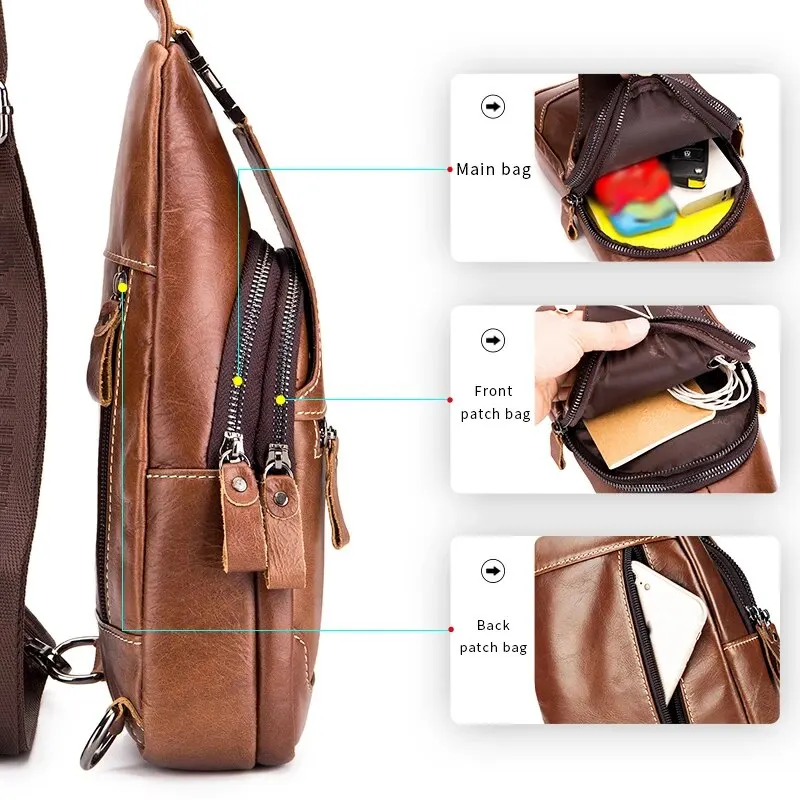
Professional storage typically costs $15-50 monthly depending on the value of items and services provided. While significantly more expensive than home storage, it may be justified for collector-grade leather goods.
Maintenance Schedule During Long-Term Storage
Even in storage, leather backpacks benefit from regular maintenance. Follow this schedule to ensure your backpack remains in optimal condition:
Monthly Tasks (5-10 minutes):
- Visual inspection for any developing issues
- Check storage environment (temperature, humidity)
- Ensure proper positioning is maintained
- Verify no items are pressing against the backpack
Quarterly Tasks (15-20 minutes):
- Remove from storage and air out for 24 hours
- Gently wipe exterior with a clean, soft cloth
- Check for any signs of dryness or mold
- Reposition stuffing materials
- Rotate position if stored lying flat
Bi-Annual Tasks (30-45 minutes):
- Complete removal of all stuffing
- Thorough inspection of all areas including interior
- Light conditioning if leather appears dry
- Replace silica gel packets or other humidity control
- Replace or wash dust cover if needed
- Refresh and replace stuffing materials
Seasonal transitions (particularly from winter to summer) often bring humidity changes that require special attention. During these periods, check stored leather backpacks more frequently for the first few weeks after the season changes.
Essential Storage Tools and Supplies Checklist
Gathering the right supplies before storing your leather backpack ensures you can properly protect your investment. Here’s what you’ll need:
Cleaning and Conditioning Supplies:
- Soft, lint-free cloths (microfiber works well)
- Leather-specific cleaner compatible with your leather type
- Appropriate leather conditioner
- Soft brushes for suede/nubuck (if applicable)
- Hardware cleaner for metal components
Structural Support Materials:
- Acid-free tissue paper (preferred) or white cotton fabric
- Bubble wrap (for rigid support areas)
- Small fabric tubes for strap support
- Backpack shaper or form (optional premium option)
Environmental Control:
- Hygrometer to monitor humidity
- Silica gel packets for humidity absorption
- Unscented cedar blocks for natural moisture control (optional)
- White cotton gloves for handling (prevents oil transfer)
Protective Covers:
- Cotton dust bag or pillowcase
- Breathable fabric storage bag
- Acid-free box for additional protection (optional)
Budget-friendly alternatives include using clean white t-shirts instead of tissue paper, clean white pillowcases as dust covers, and homemade sachets with rice as moisture absorbers (replace every 2-3 months).
Is Your Leather Backpack Ready for Storage? The Final Checklist
Before concluding your leather backpack storage preparation, verify that you’ve covered all essential steps with this final checklist:
☐ Completely emptied of all contents?
☐ Thoroughly cleaned inside and out?
☐ Hardware cleaned and protected?
☐ Properly conditioned and fully dry?
☐ Stuffed appropriately to maintain shape?
☐ All straps and handles supported?
☐ Covered with breathable material?
☐ Positioned correctly (not hanging by straps)?
☐ Stored in suitable environmental conditions?
☐ Protected from direct light exposure?
☐ Free from weight or pressure from other items?
☐ Maintenance schedule established?
If you’ve answered “no” to any of these questions, take time to address these areas before completing your storage process. Remember that proper storage is an investment in your leather backpack’s longevity.
The time you spend preparing your leather backpack for storage directly correlates to how well it will emerge from storage. With these expert techniques, your premium leather backpack will remain a faithful companion for years to come, developing character and patina that makes it uniquely yours.
